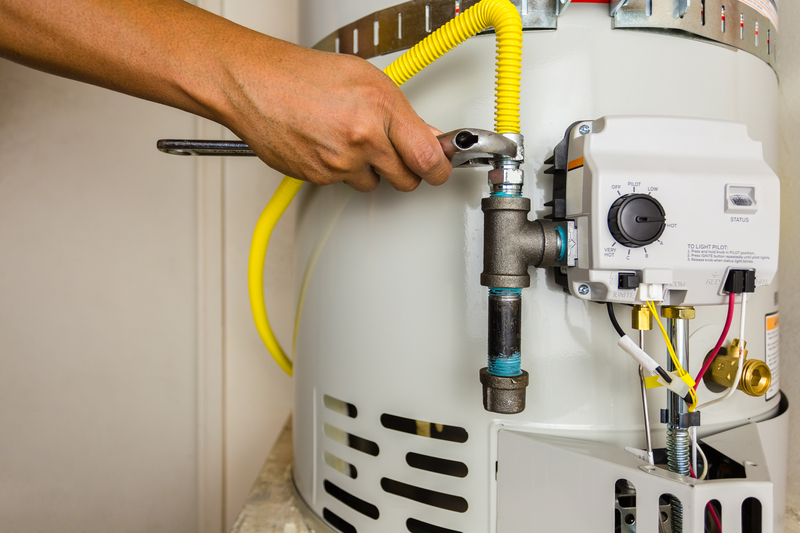Whether it’s time to replace your water heater or install one for the first time, it’s important to understand the difference between natural gas and electricity so you know which energy source to use when powering your appliance. You may already have a preference for using a tank or tankless water heater, but you’ll still need to compare gas and electricity before making a decision. In this article, we’ve gathered all the pros and cons of gas versus electric to help you choose the best option.
What is My Current Heater Powered By?

If you’re wondering which power source your current appliance uses, don’t worry, you’re not the only one who needs to be reminded. The key difference in their appearance is that gas water heaters have a pilot light, which is a blue flame located behind the side access panel, and electric water heaters don’t. The difference in their build isn’t the only thing that sets them apart, but it’s good to know which one you’re familiar with.
Once you know which element your current heater is powered by, start asking yourself the following questions to figure out whether or not you would be more satisfied by its alternative:
How many of my appliances require water to heat quickly?
Gas-powered water heaters heat up quickly, while electricity-powered water heaters take a little longer. If you’re powering an office water heater, you don’t necessarily need the ability for your water to heat fast. However, if you’re powering something like an apartment building or hotel where multiple people may need access to hot water at the same time, you’ll probably want to choose a gas water heater.
Does my current heater take up too much space?
Electric water heaters are best for areas with limited space because they’re usually made more compact. Gas water heaters are larger because they’re installed with pipes feeding from outside your building, and generally just need a little extra space to breathe. So if space matters, electric is the option for you. Buying a tankless water heater may be something you should start considering as well.
Am I practicing enough energy efficiency?

If you’re extra conscious of the environmental impact your appliances have, you’ll probably want to go with an electric hot water heater as they’re made to operate a little more eco-friendly. They also have the potential to utilize renewable energy eventually, while gas hot water heaters are powered by non-renewable energy. If gas still ends up being the better option for you, there are some energy efficient gas-powered heaters you can look into. Alternatively, you can combat the impact gas usage has on your carbon footprint by replacing other utilities with energy efficient products.
What energy source is my home or building equipped with?
Changing your water heater from one energy source to another isn’t a job you can do on your own. Converting from gas to electric requires both a plumber and electrician to get the job done. On the other hand, converting from electric to gas requires adding gas piping, a power vent model and there natural gas has to be available in your area. You’re also going to be even more limited if your home doesn’t have a chimney, as that will require a specific model as well.
Other Factors to Consider
After identifying which factors you like about your current water heater and which you want to change, you should have a little bit of an idea as to which power source you’re leaning towards. To further educate you, let’s take a look at other factors to consider before you make your decision.
Cost Comparison
The monthly operating cost to run a gas or electric water heater depends on how much heating and water you need to use, how big the space you’re heating is, and the area’s gas or electricity pricing. Usually, gas-powered water heaters are less per month, but installation costs are usually higher and dependent on whether or not you have an existing gas line. Electricity-powered water heaters have a lower upfront cost because they’re usually easier to install, but tend to cost more on your monthly electricity bill.
Power outages
Because electric water heaters are powered by electricity, they won’t work during a power outage. This means you may need to invest in a power generator if you haven’t already. Because gas water heaters run on a different energy source, they won’t be impacted by any power outages.
Maintenance and safety
Both appliances require minimal maintenance. Flushing the heater a few times each year is all you’ll need to do, but it’s wise to set reminders for yourself to do so. If you forget, you risk reducing your heater’s efficiency and lifespan. Gas heaters do require a little extra maintenance, as it is recommended gas lines be checked regularly to prevent leaks, which could potentially be a safety hazard.
Final Pros and Cons Summary

To summarize and help you confirm your decision, read through the gas vs. electric water heater pros and cons listed all together below.
Gas Water Heater Pros
- Lower operating cost (which means a lower electricity bill)
- Still works during a power outage
- Heat water faster
- Less regular maintenance required
- Uses less energy overall
Cons
- Higher installation cost
- Higher safety risk
- Less efficient energy source
- Requires more space
- Not available in all areas
- Harder to switch to
Gas hot water heaters are optimal for businesses such as hotels, apartment complexes, gyms, and any other building with appliances that require a lot of water that warms quickly. Remember to research whether or not there’s any natural gas near you before setting your sights on a gas water heater.
Electric Water Heater Pros
- Lower installation cost
- Lower safety risk
- The more efficient energy source
- Requires less space
- Available in more areas
- Easier to switch to
Cons
- Higher operating cost (which means a higher electricity bill)
- Won’t work during a power outage
- Doesn’t heat water as fast
- More regular maintenance required
- Uses more energy overall
Electric hot water heaters are optimal for office buildings, retail stores, warehouses, and any building that doesn’t use as much hot water simultaneously. Electricity is available almost everywhere, so it’s also a more accessible energy source.
We hope you found thig post helpful and be sure to check out some of our other energy efficiency tips for your small business!


Local Law 97 will have a large impact on building owners throughout New York City. In fact buildings are one of the top contributors of carbon emissions, and NYC’s residential and commercial buildings contribute roughly 70% of total CO2 emissions. As a result, when NYC Council was considering a climate change mitigation strategy, reducing emissions of built infrastructure was a priority. NYC’s newly-passed Climate Mobilization Act or “Green New Deal” includes one important centerpiece for building owners and landlords. Local Law 97 requires buildings larger than 25,000 square feet to meet strict greenhouse gas emissions limits. These new limits start in 2024 and buildings who don’t comply will face hefty fines. This new law will affect 50,000 buildings across the city.
What is Local Law 97?
Local Law 97 sets emission limits on NYC’s large commercial and residential buildings. The goal of this law is to stimulate building retrofits, thus reducing emissions in two phases:
- Initial period of 2024-2029
- Second period of 2030-2034
Emission limits are set based on type of occupancy spaces within the building. For instance, a mixed-use building, with a ground floor serving as retail space and the rest as residential, calculates its emission limits proportionately to the square footage of type of space. Here is a list of carbon emission limits by occupancy classifications:
Local Law 97 2024-2029 CHG Targets
- Hospitals- 0.02381 (tons/sf)
- Laboratories, Civic Emergency- 0.02381 (tons/sf)
- High Hazzard- 0.02381 (tons/sf)
- Mercantile- 0.01181 (tons/ sf)
- Senior Assisting Living- 0.01138 (tons/sf)
- Assembly- 0.01074 (tons/sf)
- Hotels & Dormitories- 0.00987 (tons/sf)
- Business- 0.00846 (tons/sf)
- Education- 0.00758 (tons/sf)
- Daycare- 0.00758 (tons/sf)
- Residential, Multifamily- 0.00675 (tons/sf)
- Factory & Industrial- 0.00574 (tons/sf)
- Storage- 0.00426 (tons/sf)
- Parking- 0.00426 (tons/sf)

Starting from May 1, 2025, building owners must report emissions from the previous year. Under Local Law 97 GHG emissions that exceed the building’s GHG budget are subject to a penalty. The penalty at the time the bill was passed is $268 per metric ton of CO2e. Houses of worship, buildings with regulated units and other forms of affordable housing are excluded from the bill. The Deal also establishes the Property Assessed Clean Energy (PACE) program to facilitate retrofits through long-term financing, and requires installation of solar PV and green roofs on new buildings and major renovations. PACE financing is tied to the property and not the owner, allowing obligations to be transferred to a new owner when the property is sold and assuaging concerns about securing long-term savings from large retrofit investments.
How to Test for Carbon Emissions Under Local Law 97
How to Reduce Carbon Emissions to Meet Local Law 97 Goals
The time and costs required to reduce buildings’ emissions can vary significantly from building to building. It’s important to begin assessing and improving your compliance as soon as possible. To reduce emissions building owners can implement:
- Energy efficiency strategies
- Behavioral change programs and deductions
- GHG offsets
- Investments in clean distributed energy sources
- Renewable energy credits (REC)
What is Local Law 97?
 Local Law 97 sets emission limits on NYC’s large commercial and residential buildings. The goal of this law is to stimulate building retrofits, thus reducing emissions in two phases:
Local Law 97 sets emission limits on NYC’s large commercial and residential buildings. The goal of this law is to stimulate building retrofits, thus reducing emissions in two phases:
- Initial period of 2024-2029
- Second period of 2030-2034
Local Law 97 2024-2029 CHG Targets
- Hospitals- 0.02381 (tons/sf)
- Laboratories, Civic Emergency- 0.02381 (tons/sf)
- High Hazzard- 0.02381 (tons/sf)
- Mercantile- 0.01181 (tons/ sf)
- Senior Assisting Living- 0.01138 (tons/sf)
- Assembly- 0.01074 (tons/sf)
- Hotels & Dormitories- 0.00987 (tons/sf)
- Business- 0.00846 (tons/sf)
- Education- 0.00758 (tons/sf)
- Daycare- 0.00758 (tons/sf)
- Residential, Multifamily- 0.00675 (tons/sf)
- Factory & Industrial- 0.00574 (tons/sf)
- Storage- 0.00426 (tons/sf)
- Parking- 0.00426 (tons/sf)
 Starting from May 1, 2025, building owners must report emissions from the previous year. Under Local Law 97 GHG emissions that exceed the building’s GHG budget are subject to a penalty. The penalty at the time the bill was passed is $268 per metric ton of CO2e. Houses of worship, buildings with regulated units and other forms of affordable housing are excluded from the bill.
The Deal also establishes the Property Assessed Clean Energy (PACE) program to facilitate retrofits through long-term financing, and requires installation of solar PV and green roofs on new buildings and major renovations. PACE financing is tied to the property and not the owner, allowing obligations to be transferred to a new owner when the property is sold and assuaging concerns about securing long-term savings from large retrofit investments.
Starting from May 1, 2025, building owners must report emissions from the previous year. Under Local Law 97 GHG emissions that exceed the building’s GHG budget are subject to a penalty. The penalty at the time the bill was passed is $268 per metric ton of CO2e. Houses of worship, buildings with regulated units and other forms of affordable housing are excluded from the bill.
The Deal also establishes the Property Assessed Clean Energy (PACE) program to facilitate retrofits through long-term financing, and requires installation of solar PV and green roofs on new buildings and major renovations. PACE financing is tied to the property and not the owner, allowing obligations to be transferred to a new owner when the property is sold and assuaging concerns about securing long-term savings from large retrofit investments.
How to Test for Carbon Emissions Under Local Law 97
So what does Local Law 97 mean for building owners? The first step is to calculate your building’s current emissions. This can be done by inputting the type and quantity of fuel used in the building into the free US EPA’s Energy Star Portfolio Manager. This will allow you to gauge the excess emissions you need to eliminate in order to comply with the new law.’ If your building is in the process of completing your Local Law 87 energy audit, this could be a good place to start. Ask your energy auditor to look into longer-term energy saving strategies.How to Reduce Carbon Emissions to Meet Local Law 97 Goals
The time and costs required to reduce buildings’ emissions can vary significantly from building to building. It’s important to begin assessing and improving your compliance as soon as possible. To reduce emissions building owners can implement:- Energy efficiency strategies
- Behavioral change programs and deductions
- GHG offsets
- Investments in clean distributed energy sources
- Renewable energy credits (REC)